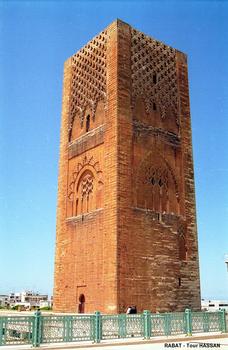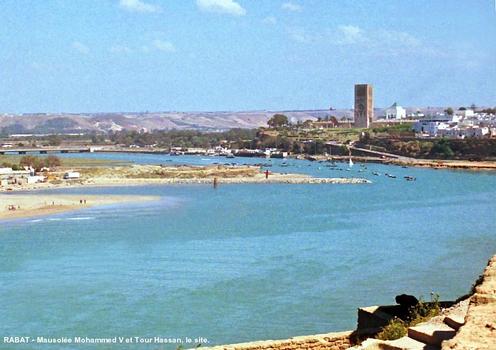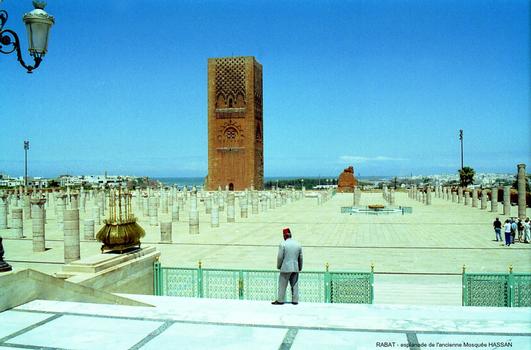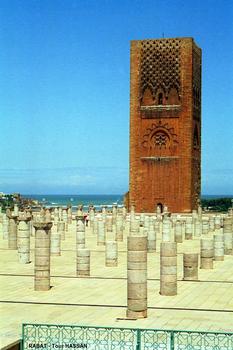General Information
Project Type
| Function / usage: |
Minaret |
|---|---|
| Material: |
Load-bearing masonry tower |
Location
| Location: |
Rabat, Rabat-Salé-Kénitra, Morocco |
|---|---|
| Coordinates: | 34° 1' 26.88" N 6° 49' 22.36" W |
Technical Information
Dimensions
| tower | height | 44 m |
Excerpt from Wikipedia
Hassan Tower or Tour Hassan (Arabic: صومعة حسان) is the minaret of an incomplete mosque in Rabat, Morocco. Commissioned by Abu Yusuf Yaqub al-Mansur, the third Caliph of the Almohad Caliphate in 1195, the tower was intended to be the largest minaret in the world along with the mosque, also intended to be the world's largest. When al-Mansur died in 1199, construction on the mosque stopped. The tower reached 44 m (140 ft), about half of its intended 86 m (260 ft) height. The rest of the mosque was also left incomplete, with only the beginnings of several walls and 348 columns being constructed. The tower, made of red sandstone, along with the remains of the mosque and the modern Mausoleum of Mohammed V, forms an important historical and tourist complex in Rabat.
Yaqub al-Mansur
Founder of the Hassan Tower Yaqub al-Mansur was a member of the Almohad Caliphate, a Berber Muslim empire in the Maghreb and Iberia. The tower, according to some traditions, was designed by an astronomer and mathematician named Jabir ibn Aflah who was also supposed to have designed Hassan's sister tower, the Giralda of Seville in Al Andalus (modern day Spain). Both of the towers were modeled on the minaret based on the Koutoubia Mosque in Marrakech, but also drew influence from the ancient Egyptian Lighthouse of Alexandria for its height and method of ascendancy, a series of ramps.
Yaqub al-Mansur conducted other works in Rabat, most notably reconstruction of the Kasbah of the Udayas and conversion of the Chellah ancient complex, built by the Phoenicians and Romans, to a necropolis usage.
Structure
The mosque is strategically placed on the high south bank of the Bu Regreg river to provide an imposing spectacle visible for miles around. Since the area surrounding was suburban at the time of construction and lacked the population to regularly fill the mosque, historians have been led to believe that it was built to serve double-duty as both a place of worship and as a fortress.
Instead of stairs, the tower is ascended by ramps, which would have allowed the muezzin to ride a horse to the top to issue the call to prayer. At the center of each of the six floors would have been a vaulted chamber surrounded by the ramps and lit by the horseshoe-shaped windows set into the sides of the tower. Its exterior is decorated with panels of sebka patterning as well as engaged columns and capitals carved from the same sandstone as the tower itself, but retains one marble capital of Andalusi spolia.
Notably, the mosque was given cylindrical stone columns rather than the brick piers more commonly seen in Almohad architecture. These columns were to be formed from drums of differing height, an idea that, while innovative at the time, slowed down construction significantly and contributed to the mosque's unfinished state. The plan originally included three small inner courtyards, one in the back, parallel to the qibla, and the other two on either side of the prayer hall, allowing daylight and fresh air to flow in through the arcades.
In addition to being incomplete, the mosque sustained some damage in the 1755 Lisbon Earthquake.
World heritage status
This site was added to the UNESCO World Heritage Tentative List on July 1, 1995 in the Cultural category. It was granted World Heritage Status in 2012.
Text imported from Wikipedia article "Hassan Tower" and modified on July 23, 2019 according to the CC-BY-SA 4.0 International license.
Participants
Currently there is no information available about persons or companies having participated in this project.
Relevant Web Sites
- About this
data sheet - Structure-ID
20019236 - Published on:
28/01/2006 - Last updated on:
28/05/2021









